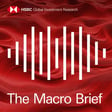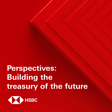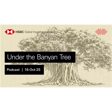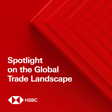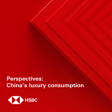Become a Creator today!Start creating today - Share your story with the world!
Start for free
00:00:00
00:00:01

MarkeTalks: Portfolio Trends in 2024 – What will the Future Hold?
The landscape of Quantitative Investment Strategies has evolved considerably over the last 10 years. It has gone from focusing on building strategies targeting a single solution for a number of different scenarios, to now focusing on creating strategies targeting specific risk premia and that means understanding what risks markets are facing. Gabriela Tennhard, Global Head of Market & Strategic Insights for Markets & Securities Services, HSBC, is joined by James Pomeroy, Global Economist & Max Kettner, Chief Multi-Asset Strategist, both from HSBC Global Research, and Karim Traore, Head of EMEA QIS Solutions, HSBC Markets & Securities Services, as they give us an update of the current macro landscape and the outlook for equities and bonds in the short to medium term, by clicking on one of the buttons below.
Hosted on Acast. See acast.com/privacy for more information.
Transcript
Introduction to Podcast Series
00:00:00
Speaker
Welcome to HSBC Global Viewpoint, the podcast series that brings together business leaders and industry experts to explore the latest global insights, trends, and opportunities.
00:00:12
Speaker
Make sure you're subscribed to stay up to date with new episodes.
00:00:15
Speaker
Thanks for listening.
00:00:16
Speaker
And now onto today's show.
2024 Global Market and Portfolio Trends
00:00:22
Speaker
Welcome to the latest in our Market Talks podcast series.
00:00:27
Speaker
We will be featuring a variety of different topics and market developments that are currently trending globally and explore portfolio trends in 2024.
00:00:35
Speaker
What will the future hold?
Economic Landscape Discussion with Experts
00:00:39
Speaker
In today's episode, I'm joined by James Pomeroy, Global Economist at HSBC Global Research, and Max Kettner, Chief Multi-Asset Strategist at HSBC Global Research, who will discuss the macro landscape and the outlook for equities and bonds.
00:00:58
Speaker
After the break,
00:00:59
Speaker
I will discuss the latest QoIS trends for 2024 with Karim Traore, head of EMEA QoIS Solutions, markets and security services at HSBC.
00:01:11
Speaker
The landscape of quantitative investment strategies, or QIS, has evolved considerably over the last 10 years.
00:01:19
Speaker
It has gone from focusing on building strategies targeting a single solution for a number of different scenarios, to now focusing on creating strategies targeting specific risk premia.
00:01:32
Speaker
And that means understanding what risks markets are facing.
00:01:36
Speaker
So James, thank you so much for joining us.
00:01:39
Speaker
So could you provide us with an overview of the current macro landscape and why it differs from anything we've seen before?
Global Economy Uncertainties
00:01:46
Speaker
Well, we've obviously been through a period of great uncertainty in the global economy over the course of the last three years or so, and it's not getting any easier.
00:01:54
Speaker
The challenges are still out there for central banks, for companies, for individuals, and there's a huge amount of uncertainty.
00:02:00
Speaker
And that uncertainty is happening because there's a huge divergence in what's happening in the global economy.
00:02:04
Speaker
You've got certain areas that are doing pretty well.
00:02:06
Speaker
That's generally parts of the economy that involve services, just particularly discretionary services, so travel, tourism, recreation.
00:02:12
Speaker
That part of the global economy is doing pretty well.
00:02:15
Speaker
Wages are going up, employment's going up.
00:02:18
Speaker
That's helping to contribute to that sort of staying pretty robust.
00:02:21
Speaker
So that part of the economy looks pretty good.
00:02:23
Speaker
But there's a huge amount of challenges out there and they include mostly around the manufacturing sector.
00:02:28
Speaker
So we had this huge boom in global goods consumption during the height of the pandemic.
00:02:32
Speaker
That has slowed down quite dramatically.
00:02:34
Speaker
We've seen businesses build inventory and it's hard to see where those sort of new orders now are coming from.
00:02:38
Speaker
End demand's not strong.
00:02:40
Speaker
Those orders to fill up inventories aren't coming through.
00:02:42
Speaker
And global trade looks really, really weak.
00:02:44
Speaker
So you've got this sort of differentiation happening between global goods and global services.
00:02:49
Speaker
And that basically clouds that economic outlook.
Interest Rates and Global Growth Risks
00:02:52
Speaker
And then you've got to weigh that up against sort of this risk of higher interest rates, which central banks have responded to high inflation by taking interest rates up to four, five and higher percent, depending on where you are in the world.
00:03:03
Speaker
And that's basically now filtering through into various parts of the economy at different speeds.
00:03:07
Speaker
So some places you've seen it really clearly, some places you haven't seen it at all.
00:03:11
Speaker
And so there's this great uncertainty about the impact of high rates on the economy through the rest of 2023 and in 2024.
00:03:19
Speaker
And so you've got to weigh up this sort of relatively robust trend
00:03:21
Speaker
sort of services side of the economy, employment side of the economy at the moment, against this lingering risk of high rates hitting the economy.
00:03:28
Speaker
And so much of that impact is going to come down to what happens with inflation, which is looking slightly better.
00:03:33
Speaker
We have seen some better numbers in the US in particular, in Asia, in Latin America, but not yet in Europe.
00:03:39
Speaker
And so central banks are sort of torn between whether they can start to cut rates, which we've seen in some places like in Latin America,
00:03:45
Speaker
or whether they need to keep them high for longer, like we're likely to see in Europe.
00:03:48
Speaker
And that risk from higher rates is what's probably dominating a lot of people's minds at the moment, that those interest rates, particularly in Europe, maybe also in the US, staying higher for longer.
00:03:57
Speaker
Will that impact become more evident and does that weigh on global growth in 2024?
00:04:02
Speaker
Almost Dr. Jekyll and Mr. Hyde scenario, isn't it?
00:04:04
Speaker
Exactly.
00:04:05
Speaker
I mean, it really does depend on who you are.
00:04:07
Speaker
I mean, if you're a hotel operator, this is fantastic.
00:04:10
Speaker
Everyone's staying in hotels, everyone's spending on that side of the economy.
00:04:13
Speaker
If you're producing furniture, it's probably not great.
00:04:16
Speaker
And there's a sort of differentiation both by sector and also on who you
Varied Economic Impacts Across Sectors
00:04:20
Speaker
are.
00:04:20
Speaker
You've got high income households who are doing fantastically well, who've got savings, who are now getting a return on those savings.
00:04:25
Speaker
You've got low income households who are still facing a massive cost of living squeeze from high
00:04:29
Speaker
higher energy prices, higher food prices, higher rental costs.
00:04:32
Speaker
So there's a big differentiation depending on who you are in the economy, what business you are, what level of income you've got, and where you are in the world as well, because Europe is still seeing much higher inflation rates than elsewhere.
00:04:43
Speaker
Thanks, James.
00:04:44
Speaker
So hopefully 2023 isn't over yet.
00:04:47
Speaker
So hopefully, as you mentioned, there will be some positive news by the end of 2023 and starting 2024.
00:04:54
Speaker
Thanks so much for joining us, James.
00:04:56
Speaker
Max, welcome.
00:04:58
Speaker
So we're speaking of the future, as I just mentioned,
Equities and Bonds Uncertainty
00:05:01
Speaker
2024.
00:05:01
Speaker
What is the outlook for equities and bonds in the next year or in the next quarters?
00:05:05
Speaker
Yeah, look, I guess what we have right now is still an environment that is very, very different to what we've been used to.
00:05:13
Speaker
We've been used to a world which is very, very sort of risk on, risk off, right?
00:05:18
Speaker
And we had that in 2010s, where essentially, you know, if things go risk on, you buy equities, you buy high yield credit, you buy risk assets in general.
00:05:28
Speaker
And then if you risk off, you buy bonds, right?
00:05:30
Speaker
So you have this very negative correlation and persistently negative correlation
00:05:35
Speaker
between sovereign bonds in particular and risk acids more broadly, whether that is high yield credit, whether it's equities, whether it's emerging market debt or emerging market equities or currencies.
00:05:47
Speaker
There's been this general negative correlation between risk acids and developed market sovereigns, which always sort of acted as a
00:05:58
Speaker
as a hedge or at least as a diversifier in the last 20, 30 years.
00:06:02
Speaker
And that started to change, right?
00:06:04
Speaker
The really, really challenging bit right now is that, you know, as we went into this year, as we went into 2023, a lot of people were saying, look, we're going to get this recession.
00:06:13
Speaker
We're going to get this big margin squeeze.
00:06:16
Speaker
particularly in the US.
00:06:18
Speaker
And that means we're going to move away from inflation concerns towards growth concerns.
00:06:24
Speaker
And if we move towards growth concerns, then that old risk on risk off world returns and bonds can finally, you know, act as a hedge again.
00:06:32
Speaker
That hasn't happened yet, right?
00:06:33
Speaker
We're still very, very worried about inflation is, you know, are we on the uptake of or a bit of an inflation bump, particularly in the US again, James has just said,
00:06:44
Speaker
In Europe, it's a bit more sticky.
00:06:45
Speaker
So we're not yet in that world, again, where it's risk on, risk off.
00:06:51
Speaker
But what we would classify much more as a Goldilocks world or a reverse Goldilocks world, right?
00:06:57
Speaker
In the Goldilocks world, which we were in for most of this year, which is broadly basically you're buying growth
Market Volatility and Traditional Correlations
00:07:05
Speaker
in equities, right?
00:07:05
Speaker
You're buying tech, for example, really the growth titles in equities, right?
00:07:10
Speaker
You're buying carry assets, emerging market debt, high yield credit, you're going, you know, you don't like volatility.
00:07:16
Speaker
Actually, volatility in the Goldilocks period is usually very, very subdued.
00:07:22
Speaker
Whereas, you know, the dollar really, really does quite badly in those environments.
00:07:26
Speaker
Whereas what we've seen now in September is the exact opposite, right?
00:07:29
Speaker
It's reverse Goldilocks where you're saying actually nothing works, right?
00:07:33
Speaker
Except for the dollar and holding cash in dollar, nothing works.
00:07:37
Speaker
Whether you're in sovereign bonds or in equities or in high yield or in IG or in emerging markets, it doesn't matter.
00:07:44
Speaker
Nothing works.
00:07:45
Speaker
So the outlook from here, I think, is still pretty similar that we are going to flip.
00:07:50
Speaker
in between those extremes, right?
00:07:51
Speaker
It is going to be much more challenging because before that, in particularly in the 2010s, the market timing wasn't that crucial, right?
00:08:00
Speaker
Because you could always sort of rely on that negative correlation between risk assets and fixed income.
00:08:06
Speaker
Whereas now, if we're flipping between those two extremes,
00:08:10
Speaker
Very likely the correlation between sovereign bonds and risk assets is not yet returning back to those negative levels that we have been accustomed to for such a long period.
00:08:24
Speaker
And that means market timing is much, much more important.
00:08:27
Speaker
Wow, Max.
00:08:28
Speaker
And when do you see this changing or you can't see anything yet?
00:08:33
Speaker
I can't see anything yet.
00:08:34
Speaker
What James has been outlining is very different, actually.
00:08:37
Speaker
And I think our economic outlook has been very, very different to consensus to what the street's been thinking for most of 2023.
00:08:45
Speaker
Bear in mind, we entered again, right?
00:08:47
Speaker
We entered 2023.
00:08:48
Speaker
And the huge consensus is we're going to get a big margin squeeze.
00:08:52
Speaker
We're going to get an earnings recession at least 15, 20 percent.
00:08:56
Speaker
We're going to get a recession in the first half and then the Fed will pivot dovish.
00:09:02
Speaker
And then in the second half, we're going to recovery.
00:09:04
Speaker
So according to the consensus opinion from 10, 11 months ago, we should now already be in the recovery and the recession should have happened three months ago.
00:09:13
Speaker
Obviously, none of that happened.
00:09:15
Speaker
The reality is that even the US economy overall is still much, much stronger.
00:09:20
Speaker
We're still having a lot of fiscal stimulus coming through.
00:09:24
Speaker
Overall, the economy in particular relative to those pretty gloomy consensus expectations
00:09:30
Speaker
is still doing much, much better than many people thought.
00:09:33
Speaker
So that makes it honestly very, very tricky to think, oh yeah, just give it six months and we're all going to focus on recession.
00:09:40
Speaker
And in six months, things are going to be absolutely grim.
00:09:43
Speaker
And then finally, that negative correlation will kick in again.
00:09:46
Speaker
That's very, very tricky to imagine.
00:09:48
Speaker
It's much more something perhaps in 18, 24 months down the line, not really something for the next six to 12 months.
Wrap-up and Market Outlook
00:09:56
Speaker
We live in interesting times, don't we?
00:09:58
Speaker
It's fascinating what you've been saying, Max.
00:10:01
Speaker
So thank you so much for both of you for joining.
00:10:04
Speaker
This was very helpful in understanding of what markets are facing today.
00:10:08
Speaker
And just a note to our listeners, you can get more research content by following the Macro Brief Podcast by HSBC Global Research.
00:10:16
Speaker
James, Max, thank you so much for joining this part of the session.
Investor Challenges: Liquidity and Diversification
00:10:24
Speaker
And we are back.
00:10:26
Speaker
We are joined now by Karim Traore and he's going to tell us how our clients are dealing with the risks of today.
00:10:35
Speaker
So Karim, could we start by providing an overview of the challenges faced by our clients in their multi-asset allocation in light of the current macro environment?
00:10:47
Speaker
2022 was challenging for both global equities and global bonds, and hence investors were not realizing the type of expected returns through the traditional diversification of the 60-40 portfolio.
00:10:59
Speaker
Then uncertainties and lack of market consensus on asset class performance during 2023 meant that a number of investors de-risked their portfolios and underperformed the benchmarks.
00:11:13
Speaker
The LDI crisis in the UK in fall last year has also highlighted liquidity risk.
00:11:18
Speaker
So it's important for investors to have in place a liquidity strategy alongside an investment strategy.
00:11:26
Speaker
Generally speaking, quantitative investment strategies, or QIS, are investments or hedging strategies that systematically enter into a long and or a short position in a given set of financial instruments.
Strategies for Risk and Liquidity Management
00:11:40
Speaker
Stocks, options, futures, for example.
00:11:44
Speaker
They are driven by a predetermined set of rules, algorithms, which determine the quantities invested at any point in time.
00:11:53
Speaker
Specifically, multi-asset portfolios have undertaken a number of tasks.
00:11:58
Speaker
One, reduce non-diversification risk by looking for assets that can offer decorrelation at times where traditional asset classes do not, while at the same time not increasing liquidity risk.
00:12:12
Speaker
This would require thinking out of the box and looking for either market-neutral investments or liquid hidden assets derived from the traditional asset classes, but which have become assets in their own right.
00:12:24
Speaker
Volatility, correlation, term structure are examples.
00:12:29
Speaker
Second, manage drawdown risk within the equity portfolio through either an appropriate hedging overlay or a replacement by better suited equity premium strategies.
00:12:41
Speaker
Third, reduce duration risk within the bond allocation through either an appropriate hedging overlay or a partial replacement with a duration-neutral fixed income strategy.
00:12:52
Speaker
Fourth, and finally, increase the liquidity of the portfolio by exploring synthetic strategies versus physical assets and building asset allocations which show robustness in extreme market scenarios.
00:13:04
Speaker
This is really interesting, Karim.
00:13:06
Speaker
So thank you for this.
00:13:08
Speaker
Now, you spoke what QIS was and some of the portfolios, what the multi-asset portfolios have undertaken.
00:13:15
Speaker
Now, can you give an overview of the QIS landscape in Europe and the Middle East specifically?
QIS Evolution and Investment Strategies
00:13:22
Speaker
Sure.
00:13:24
Speaker
Absolutely, Gabriella.
00:13:26
Speaker
The landscape of quantitative investment strategies has considerably evolved over the last 10 years.
00:13:32
Speaker
Its constant evolution and adaptation to not only the macro environment, but also the needs of our partners and investors is a testimony of the resilience of QIS as a powerful investment and risk management tool for global investors.
00:13:46
Speaker
To give a few examples of the major changes that have happened, strategies have been simplified in their design in order to be as clear as possible in terms of what they intend to capture.
00:13:58
Speaker
While in the past, industry focused on building strategies aiming at hitting multiple birds with one stone, it has now shifted towards strategies targeting a very specific risk premium.
00:14:10
Speaker
Cost has generally decreased as liquidity of underlying instruments has increased and IT investments have been made in QIS platform infrastructure.
00:14:20
Speaker
QIS keeps expanding as new frontiers have opened up, allowing investors to get exposure to premiums that were not easily accessible in a cost-efficient and transparent way before.
00:14:33
Speaker
A lot more focus has been put in assisting investors in defining quantitatively their desired outcome.
00:14:40
Speaker
Finally, a lot more focus has also been put in taking into account the specific regulatory environments of our investors in the design of the strategies.
00:14:49
Speaker
Additionally, the platform nature of QIS has led it to be used by investors in new ways which can better fit their operational constraints, constantly bridging the gap between IP generation and outsourcing of executions.
00:15:03
Speaker
Karim, thanks so much for this.
00:15:05
Speaker
So what role does quantitative strategies play in the context of this outlook?
00:15:11
Speaker
Yes, quantitative investment strategies represent a useful tool for investors, social investors in particular, to further adapt their investment and liquidity strategies to the current microcycle.
00:15:23
Speaker
Not only can they be used as a more efficient way to get exposure to traditional asset classes, but also QIS can provide multi-asset managers,
00:15:31
Speaker
with a way to extract non-traditional premia for diversification purpose.
00:15:36
Speaker
Some specific examples, extracting fixed income carry without being long bond, coming with the associated duration risk.
00:15:44
Speaker
Extracting equity premium embedded in the option markets, which can offer a less volatile way to extract performance from equity markets.
00:15:53
Speaker
Getting a sustainable exposure to diversifying premia, not only accessible using traditional asset classes.
00:16:00
Speaker
allowing investors to increase their portfolio liquidity by entering into those strategies in a synthetic format.
00:16:08
Speaker
Finally, building risk management overlays sitting alongside traditional investments and aiming at reducing drawdown risks.
00:16:15
Speaker
To conclude, due to the very flexible nature of operational robustness and constant creativity of quantitative investment strategies platform, they will continue to play a defining role in the future in helping our investors and partners in their investments and risk management.
00:16:31
Speaker
Thank you so much, James, Max, and Kareem.
00:16:34
Speaker
As a reminder, you can get more content from our award-winning research team by following the Macro Brief Podcast by HSBC Global Research.
Conclusion and Subscription Reminder
00:16:43
Speaker
You can also access the Markets and Security Services talks at Apple and Spotify under the Global Viewpoint channel.
00:16:51
Speaker
Simply search for it in Apple Podcasts or Spotify or wherever you get your podcasts.
00:16:57
Speaker
I would like to thank you for listening to this edition in our series of Market Talks podcasts.
00:17:02
Speaker
We hope that you enjoyed learning more about portfolio trends in 2024.
00:17:07
Speaker
What will the future hold?
00:17:09
Speaker
Stay tuned for more from our podcasts as we explore more trends in the coming weeks.
00:17:15
Speaker
Thank you for joining us at HSBC Global Viewpoint.
00:17:18
Speaker
We hope you enjoyed the discussion.
00:17:20
Speaker
Make sure you're subscribed to stay up to date with new episodes.
